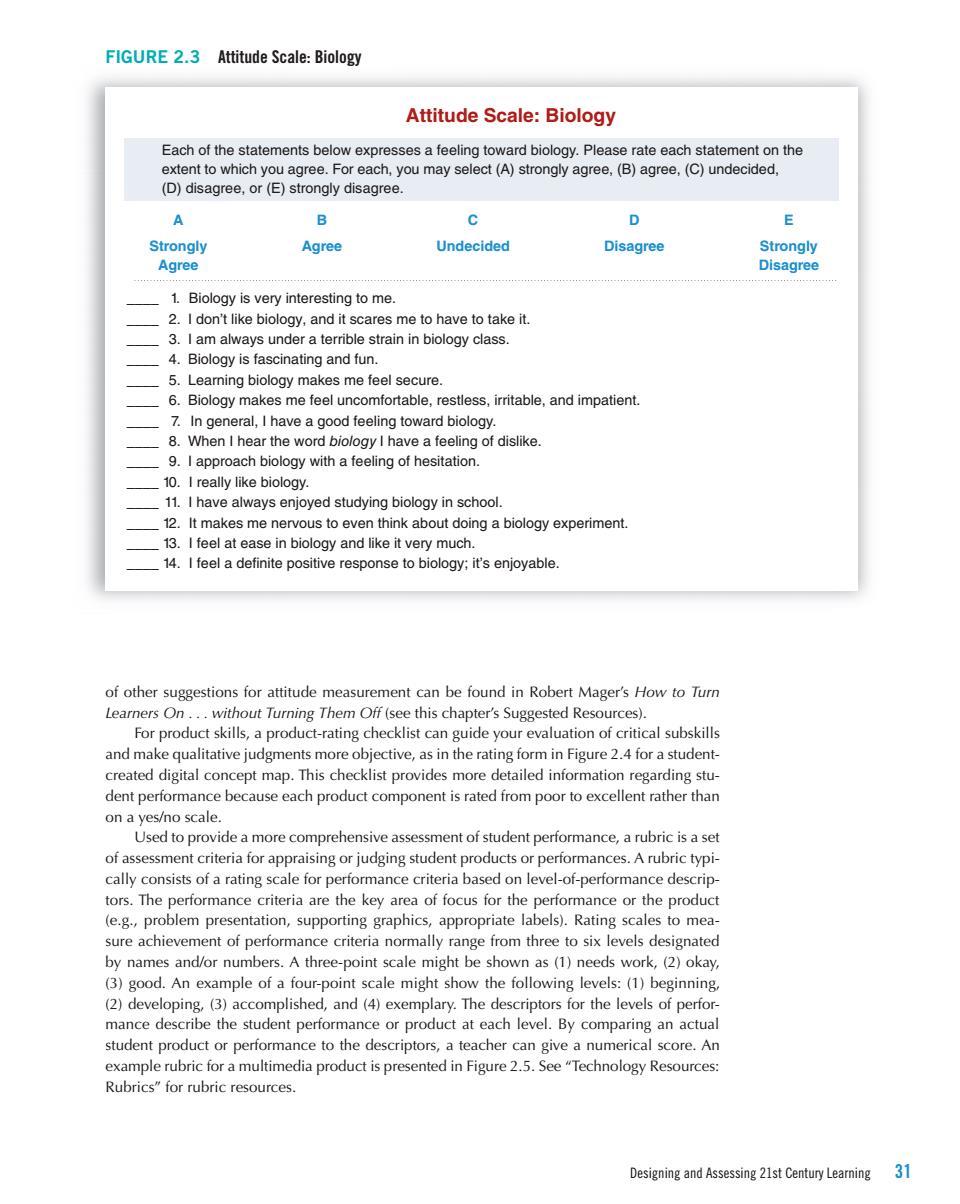正在加载图片...

FIGURE 2.3 Attitude Scale:Biology Attitude Scale:Biology (D)(E)strongly disagre B c E Strongly Agree Undecided Disagree Strongly Agree Disagree 1.Biology is very interesting to me. 2.I don't like biology,and it scares me to have to take it. 3.I am always under a terrible strain in biology class. 4.Biology is fascinating and fun. 5.Leaming biology makes me feel secure. 6.Biology makes me feel uncomfortable,restless,irritable,and impatient. 7.In general,I have a good feeling toward biology. 8.When I hear the word biology I have a feeling of dislike. 9.I approach biology with a feeling of hesitation. 10.I really like biology. 11.I have always enjoyed studying biology in school. 12.It makes me nervous to even think about doing a biology experiment. 13.I feel at ease in biology and like it very much. 14.I feel a definite positive response to biology:it's enjoyable. measurementcan be found n Robert Mager's ct-rating and eval mo Figure2.for a student created digital concept map.This che m in klist provides more etailed informatio regarding stu- dent performance because each product component is rated from poor to excellent rather than on a yes/no scale Used to provide a more comprehensive assessment of student performance,a rubric is a se of assessment criteria for appraising or judging student products or performances.A rubric typi- cally consists of a rating scale for performance criteria based on level-of-performance descrip- tors.The performance criteria are the key area of focus for the performance or the product (e.g.,problem presentation,supporting graphics,appropriate labels).Rating scales to mea sure achievement of performance criteria normally range from three to six levels designated by names and/or numbers.A three-point scale might be shown as(1)needs work,(2)okay. (3)good.An example of a four-point scale might show the following levels:(1)beginning (2)developing (3)accomplished,and(4)exemplary.The descriptors for the levels of perfor mance describe the student performance or product at each level.By comparing an actual student product or performance to the descriptors,a teacher can give a numerical score.An example rubric for a multimedia product is presented in Figure 2.5.See"Technology Resources: Rubrics"for rubric resources. Designing and Assessing 21st Century Leaming 31 Designing and Assessing 21st Century Learning 31 Attitude Scale: Biology A Strongly Agree B Agree C Undecided D Disagree E Strongly Disagree ____ 1. Biology is very interesting to me. ____ 2. I don’t like biology, and it scares me to have to take it. ____ 3. I am always under a terrible strain in biology class. ____ 4. Biology is fascinating and fun. ____ 5. Learning biology makes me feel secure. ____ 6. Biology makes me feel uncomfortable, restless, irritable, and impatient. ____ 7. In general, I have a good feeling toward biology. ____ 8. When I hear the word biology I have a feeling of dislike. ____ 9. I approach biology with a feeling of hesitation. ____ 10. I really like biology. ____ 11. I have always enjoyed studying biology in school. ____ 12. It makes me nervous to even think about doing a biology experiment. ____ 13. I feel at ease in biology and like it very much. ____ 14. I feel a definite positive response to biology; it’s enjoyable. Each of the statements below expresses a feeling toward biology. Please rate each statement on the extent to which you agree. For each, you may select (A) strongly agree, (B) agree, (C) undecided, (D) disagree, or (E) strongly disagree. Figure 2.3 Attitude Scale: Biology of other suggestions for attitude measurement can be found in Robert Mager’s How to Turn Learners On . . . without Turning Them Off (see this chapter’s Suggested Resources). For product skills, a product-rating checklist can guide your evaluation of critical subskills and make qualitative judgments more objective, as in the rating form in Figure 2.4 for a studentcreated digital concept map. This checklist provides more detailed information regarding student performance because each product component is rated from poor to excellent rather than on a yes/no scale. Used to provide a more comprehensive assessment of student performance, a rubric is a set of assessment criteria for appraising or judging student products or performances. A rubric typically consists of a rating scale for performance criteria based on level-of-performance descriptors. The performance criteria are the key area of focus for the performance or the product (e.g., problem presentation, supporting graphics, appropriate labels). Rating scales to measure achievement of performance criteria normally range from three to six levels designated by names and/or numbers. A three-point scale might be shown as (1) needs work, (2) okay, (3) good. An example of a four- point scale might show the following levels: (1) beginning, (2) developing, (3) accomplished, and (4) exemplary. The descriptors for the levels of performance describe the student performance or product at each level. By comparing an actual student product or performance to the descriptors, a teacher can give a numerical score. An example rubric for a multimedia product is presented in Figure 2.5. See “Technology Resources: Rubrics” for rubric resources. M02_SMAL4150_01_SE_C02.indd 31 2/7/14 8:38 AM